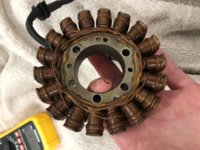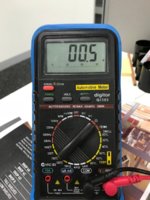Hi all, I'm not getting any charge from my banshee PMA and hope you can lend some assistance.
Pics attached.
After testing my reg and my voltmeter throwing out some weird results, i tested the stator using a good VM at work. It's showing 0.05 ohm on all 3 yellow wires. Is that OK? The tests i've seen just show "1" as per - https://www.hughshandbuilt.com/2016/03/07/how-to-inspect-and-test-your-pma-system/
I expected to see some connection issues but everything appears correct and intact.
Other question is, how does the stator look? Not too dark? The metal outside surfaces had surface rust and oil built up which i've cleaned. Could this have been the cause?
Next step is to re-check the regulator...
Pics attached.
After testing my reg and my voltmeter throwing out some weird results, i tested the stator using a good VM at work. It's showing 0.05 ohm on all 3 yellow wires. Is that OK? The tests i've seen just show "1" as per - https://www.hughshandbuilt.com/2016/03/07/how-to-inspect-and-test-your-pma-system/
I expected to see some connection issues but everything appears correct and intact.
Other question is, how does the stator look? Not too dark? The metal outside surfaces had surface rust and oil built up which i've cleaned. Could this have been the cause?
Next step is to re-check the regulator...





